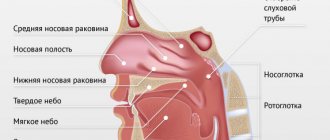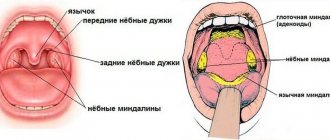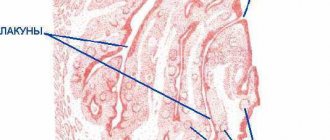Types of most likely complications
Tonsillitis develops due to the penetration of bacteria and viruses into the oropharynx, which cause pain and symptoms of intoxication. Timely intake of antibacterial agents and compliance with all doctor’s recommendations allows you to destroy the causative agent of the disease in the primary focus of microbial development. If this does not happen, there is a high probability that bacteria will spread throughout the body through the blood or lymph flow, which leads to inflammation of the internal organs.
All possible complications of any type of tonsillitis are divided into local and systemic (general). Local ones are easier to tolerate, although they lengthen the recovery time and significantly weaken the immune system. General complications are less common, but they are much more dangerous for the patient.
Local complications
The development of local complications of tonsillitis, covering the ENT organs and respiratory system, is indicated by the addition of new symptoms, deterioration of health against the background of the beginning of recovery.
The most likely consequences of a sore throat are:
- Peritonsillar abscess
. This is the formation of an abscess in the tissue of the pharynx. It is manifested by the appearance of increasing pain on one side of the throat, a secondary increase in temperature, tension in the neck muscles, and difficulty swallowing. The patient cannot turn his neck normally and open his mouth completely. - Otitis
is an inflammation of the middle ear. It occurs both in parallel with a sore throat and a few days after the completion of the acute stage of tonsillitis. - Swelling of the larynx
. Occurs due to inflammation of the vocal cords. It manifests itself as hoarseness, difficulty swallowing and deterioration in breathing. - Inflammation of the lymph nodes
. The submandibular ones are most often affected, less often the clavicular and supraclavicular, cervical ones. - If left untreated, tonsillitis can also cause bronchitis, pneumonia, and tracheitis.
What are the dangers of chronic tonsillitis and tonsillitis?
Cardiologist, head. Department of Cardiology No. 1 Varava N.K.
“Sore throat” from a medical point of view is called acute tonsillitis.
Acute tonsillitis (angina) is an acute infectious disease characterized by inflammation of the lymphoid formations of the pharyngeal ring, most often the tonsils. In common parlance, tonsils are “tonsils” that are located on the sides of the entrance to the pharynx and are clearly visible if you look into an open mouth.
It is possible to become infected with this infectious disease in several ways, the most common of which occurs through airborne droplets from a patient or a carrier of the bacilli; there is also a nutritional route of infection, i.e. through food, as well as through direct contact, but more often self-infection (autoinfection) occurs with microbes already living in the throat and manifesting themselves against the background of decreased immunity.
In the overwhelming majority of cases, the microbial causative agent of acute tonsillitis (tonsillitis) is group A beta-hemolytic streptococcus, not so often - staphylococcus, pneumococcus, adenoviruses, etc. There are a large number of people who do not themselves suffer from this disease, but are carriers of beta-hemolytic streptococcus And, they are dangerous for others, since they are the same source of infection as a sick person.
If treatment for a sore throat is not completed, the sore throat may reoccur. After suffering from a sore throat, lasting immunity does not arise, as with many other infectious diseases.
Sore throat occurs acutely with a rise in body temperature to 39-40°C (can reach 41°C). Sharp and severe pain in the throat, especially when swallowing, severe weakness, headache, enlarged lymph nodes that can be felt under the lower jaw closer to the neck - palpating them is painful. Sore throat can also occur at lower body temperatures - from 37 to 38°C, but with greater damage to the throat.
Chronic tonsillitis is a common infectious disease that has a chronic course and manifests itself in the form of persistent inflammation of the tonsils. Chronic tonsillitis is characterized by periodic exacerbations in the form of tonsillitis, but there may also be a nonanginal form of chronic tonsillitis.
As a result of prolonged interaction of microbes on the lymphoid tissue of the tonsils, persistent chronic inflammation is established in the palatine tonsils. They have all the favorable conditions for the existence and reproduction of bacteria. The tonsils are penetrated by deep crevices - lacunae (crypts), where about 30 different microbes accumulate, and from where the reverse outflow is always impaired. Therefore, chronic tonsillitis is caused by autoinfection, i.e. own infection - self-infection, the limiting factor of which is our immunity.
The main cause of chronic tonsillitis is a previous sore throat, after which the inflammatory process continues latently and takes a chronic course. But in some cases, chronic tonsillitis occurs without previous tonsillitis.
Fatigue, weakness, lethargy, headaches, elevated body temperature - these are the main symptoms that a person suffering from chronic tonsillitis complains about. These symptoms are explained by the so-called tonsillogenic intoxication and allergization of the body... Local manifestations are also present: discomfort in the throat when swallowing, putrid breath, periodic sore throat, dry cough, frequent sore throats, enlarged and painful regional (neighboring) lymph nodes.
Why is chronic tonsillitis dangerous?
Scientists have described the connection between chronic tonsillitis and more than 100 other diseases.
About 30 types of pathogenic microbes live on inflamed tonsils.
In 24% of cases, chronic tonsillitis occurs without tonsillitis.
It is recommended to stay in bed for 7-10 days if you have a sore throat. Otherwise there will be complications.
According to statistics, chronic tonsillitis affects up to 15% of the total population. Out of 200 women suffering from infertility, 120 have chronic tonsillitis.
In particular, the function of the palatine tonsils is that they produce protective substances that act on microbes that have entered the body, destroying them.
The nasopharyngeal, lingual and palatine tonsils, together with other smaller accumulations of lymphoid tissue of the pharynx and nasopharynx, form the lymphadenoid, or so-called pharyngeal ring, which is a protective barrier against infection. The palatine tonsils differ from all the components that form this ring by the presence of gaps - lacunae, which I already mentioned above; in most cases they are very deep, tortuous and branched.
Each tonsil is covered by a mucous membrane, which also lines the lacunae. Consequently, the area of the mucous membrane of the tonsils increases and, accordingly, the area of their contact with microorganisms. Between the lacunae in the thickness of the palatine tonsils there are many lymphoid follicles in which lymphocytes are formed - cells that, in turn, play an important role in the formation and maintenance of immunity.
The protective function of the mucous membrane is inherent in all lymphoid organs. But only the palatine tonsils are able to recognize a microbial agent and transmit immunological information about it to all lymphoid organs. Then antibodies are formed in the lymphoid organs (each infection has its own), which form specific immunity to various infections. For example, having only once had measles, scarlet fever, rubella, chickenpox, and smallpox, you will not become infected again, because you have already developed immunity to these infections.
That is why, even in childhood, we all receive vaccinations, i.e. They introduce a harmless dose of infection into the body so that specific immunity is developed. Take a look at the forearm of your left hand - usually there are scars left there from those same vaccinations...
There is a big “BUT” - everything said above about the immunity of the palatine tonsils applies only to healthy specimens! If chronic inflammation develops in them - tonsillitis, then as a result, a large amount of pus, consisting of dead microbes, white blood cells, cells (purulent plugs), accumulates in the lacunae of the tonsils. Tonsils clogged with pus stop working as an immune organ, and in the purulent contents of the lacunae, pathogenic microbes thrive and multiply...
The waste products of microbes from the tonsils enter the blood and other fluids of the body, poisoning it (tonsillogenic intoxication); hence fatigue, pain in muscles and joints, headaches, decreased mood, and even, in some cases, a prolonged increase in body temperature;
The tonsils become a reservoir of infection (staphylococcus, streptococcus and other microbes), from where it can spread throughout the body and cause inflammatory processes, primarily acne; prostatitis, adnexitis, inflammation of the paranasal sinuses, joints;
Organic substances decomposing in gaps may have a strong unpleasant odor;
The tonsils stop working as an immune organ, moreover, they themselves turn into a source of infection, which leads to frequent illnesses;
Frequent illnesses further weaken the immune system, which leads to intensification and further development of tonsillitis.
Chronic tonsillitis is primarily dangerous due to its complications associated with the spread of infection throughout the body. Complications of tonsillitis include: rheumatism of the heart and joints, glomerulonephritis, the formation of heart valve prolapses, purulent inflammation of the tissues of the oropharynx (peritonsillar abscess), pneumonia, inflammation of the middle ear, hearing loss due to this, exacerbation of allergic diseases.
When examining the heart, patients suffering from chronic tonsillitis are often found to have prolapse of heart valves and heart rhythm disturbances. The reason is that the protein from group A beta-hemolytic streptococcus, which often parasitizes the tonsils, is similar to the protein found in the connective tissue of the human heart and joints. As a result, response aggression of the immune system is possible not only against streptococcus, but against one’s own heart and joints. This is also explained by chronic tonsillogenic intoxication - the effect of toxins on the connective tissue structures of the heart. One of the most dangerous complications of chronic tonsillitis is rheumatism, a dangerous disease that affects the heart and joints.
Systemic complications
When a sore throat develops, an adult should always remember that failure to comply with treatment can lead to damage to:
- Hearts
. Sore throat often causes myocarditis and rheumatic damage to the heart muscle. Symptoms of complications may appear after 2-3 weeks. The main signs are arrhythmia, the appearance of increasing shortness of breath, swelling of the limbs, weakness, heart pain, and increased sweating. - Kidney
. The most likely complications of tonsillitis from the kidneys are pyelonephritis and glomerulonephritis. Renal pathologies are indicated by pain in the lumbar region, increased urination, swelling of the face and legs, lethargy, and irritability. - Sustavov
. After a sore throat, the possible development of rheumatoid arthritis. Symptoms are swelling and pain in the joints, redness of the skin where the limbs are flexed.
The most serious complications of tonsillitis are sepsis and toxic shock. They develop when bacteria spread throughout almost the entire body. The diseases are manifested by severe symptoms of intoxication, shortness of breath, difficulty breathing, and severe weakness. Treatment is carried out in intensive care conditions.
Factors in the development of sore throat
Sore throat is primarily an infectious disease. Inflammation of the tonsils can be caused by various microorganisms, primarily staphylococcus and streptococcus. In addition, the following factors can provoke a sore throat:
- hypothermia of the body;
- long exposure to polluted air;
- lack of sunlight;
- dampness;
- poor nutrition;
- unhealthy living conditions;
- overwork of a person.
Prevention of complications after tonsillitis
To prevent the development of life-threatening complications, the patient should:
- Start drug therapy as early as possible from the onset of the disease.
- Use medications prescribed by your doctor for treatment. Antibiotics are prescribed to each patient individually, taking into account the sensitivity of pathogenic microorganisms to antibacterial agents.
- During the period of rising temperature, strictly adhere to bed rest.
- Drink as much as possible. Drinking large amounts of water and unsweetened compotes accelerates the removal of microbes and their toxins from the body.
If you have complications after a sore throat, you can contact our clinic for treatment. Qualified doctors will not only conduct a thorough diagnosis and identify the slightest undesirable changes, but will also correctly select medications taking into account the type of pathogenic microbes, the patient’s age and concomitant diseases.
After the main therapy, the clinic’s doctors also give their patients a list of recommendations, compliance with which will minimize the negative impact of tonsillitis on the body.
Features of diagnosis and treatment of sore throat in children
Sore throat is one of the most common childhood diseases. Most often this happens in spring and autumn, when children's immunity is especially weakened. Weakening of the immune system occurs as a result of the following reasons:
- poor nutrition;
- non-compliance with sleep and rest schedules;
- hypothermia of the child’s body as a result of being outside;
- drinking cold drinks from the refrigerator;
- frequent viral infections.
- chronic inflammation of the tonsils (tonsillitis).
If a sore throat is suspected, the doctor may take a swab from the child’s throat for flora and diphtheria and ask for a general blood test, since certain signs may not only have a sore throat. Symptoms in the form of a white-gray coating on the tonsils are also characteristic of diphtheria. Only sore throat is treated with antibiotics, and diphtheria is treated with anti-diphtheria serum.
Similar symptoms may appear in acute tonsillitis, which is caused by viruses and fungi and requires antiviral treatment.
Sore throat in children is especially dangerous due to possible complications. The main target organs for complications of angina are the heart and kidneys. The cause of such complications is inadequate or untimely initiation of treatment for sore throat!
Treatment of sore throat in children has its own characteristics. A course of antibiotics, gargling with sage, chamomile, and a solution of soda and salt are prescribed. Children under 2 years of age are not recommended to irrigate the throat with antiseptic spray or use medications with essential oils, as this can cause spasm of the larynx. If the child’s temperature continues to rise, then you need to urgently call an ambulance.









